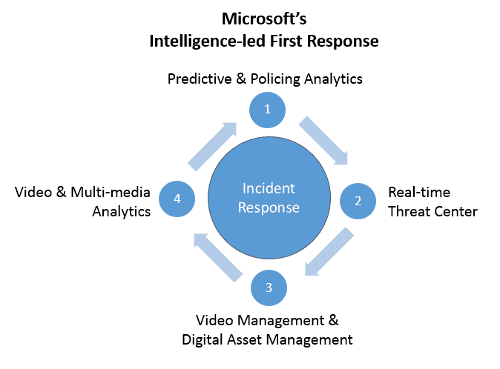Proactive approaches to policing
The recent slew of high-profile police incidents across the United States has led to demands for greater police accountability, and law enforcement agencies are responding by developing more effective and proactive approaches to policing.
In 2015 alone, public safety and justice are expected to spend an estimated $7.3 billion on technology, according to a recent article by e.Republic. This investment, which represents a 23 percent increase in the volume of emergency management bids and requests for proposals (RFPs), demonstrates the central role technology will play as public safety agencies modernize their practices.
Microsoft is helping to guide law enforcement agencies as they move to smart policing. To that end, we offer an “Intelligence-led First Response” model designed to help police departments modernize their approaches—even during a time of limited staffing and strained budgets. This model is built upon incident response and the following pillars:
Crime and Predictive Analytics: Big data is poised to take crime trends analysis and predictive analytics to a new level. Through predictive analysis, law enforcement agencies can identify the places and times with the highest risk of crime. They can also focus their limited resources on citizens at risk of becoming crime victims as well as offenders likely to commit crimes. By taking a proactive approach, law enforcement agencies can move from simply reacting to crimes to preventing them before they occur.
Take the city of Reading, Pennsylvania, for example. In 2014, the city watched major crimes drop to 6.5 percent—the lowest rate in 35 years. Reading saw fewer murders, robberies, car thefts, and burglaries. Reading’s Police Chief William M. Heim and Mayor Vaughn D. Spencer attribute the drop to the overall work the police have been doing, including predictive policing and community relations work, both implemented with limited resources.
Real-time Threat Centers: Following the Boston bombing, former New York Mayor Michael Bloomberg said that if the Boston bomb suspects had made it to Times Square, they would have come face-to-lens with the city’s “extensive network of cameras”—part of an interactive nerve center that lets police do everything from read license plates to identify suspicious packages. The interactive nerve center that Michael Bloomberg is referring to is the real-time threat center that the New York Police Department deployed in partnership with Microsoft.
By implementing an elaborate sensor network that includes technology such as surveillance cameras, body-worn cameras, gun-shot detectors, chemical, biological, radiological and nuclear (CBRN) sensors and various Internet-of-things (IoT) sensors, law enforcement agencies can develop an accurate, real-time picture of the threats they face. They can also share this information with other jurisdictions, making it easier to respond to incidents in a coordinated, collaborative manner. And they can aggregate information from myriad sources, creating an accurate, common operating picture for dynamic situations.
Video & Digital Asset Management: As police departments around the world turn to closed-circuit television (CCTV) cameras, body-warn cameras, in-car video, drone feeds, video interviews of suspects and witnesses, and other video and multi-media sources to document evidence and strengthen police accountability, they need a central place to store and manage this massive amount of video and multi-media data. By managing this information in the cloud, law enforcement can reduce the cost of storage by as much as 30 to 50 percent, while gaining access to the best security available, according to The Police Chief magazine.
The volume of video storage collected by law enforcement agencies, is expected to dramatically increase, especially due to the adoption of body-worn cameras, and so far, the benefits are impressive. According to one study of the Rialto, California Police Department, the use of force by officers wearing body-worn cameras decreased approximately 58 percent, while citizen complaints were down 88 percent.
Video & Multi-media Analytics: For video footage and digital assets to be useful, law enforcement agencies need efficient ways to analyze it—and that entails quickly searching for specific words and moments in the video and digital assets. In addition, police need automated tools to protect people’s privacy by redacting facial information before video and or digital assets are released to the public.
Currently, many law enforcement agencies lack a way to efficiently analyze video footage, and many use full-time employees to manually redact videos. Leveraging automatic redaction technologies can cut operational expenses significantly. Automated video analytics tools can make large volumes of video far easier to manage, reducing the strain on staff while lowering operational expenses.
Implemented together, crime and predictive analytics, real-time threat centers, video management, and video analytics form a comprehensive incident response solution enabling law enforcement agencies to respond more effectively to the wide range of incidents they encounter. This Intelligence-led, First-response model enables law enforcement agencies to automatically and proactively search through all data held on an investigation to look for connections and commonalities among suspects, cases, and incidents. The system reports everything about the collected data to investigators, allowing them to assess the reports, assign investigation tasks, and collaborate with other agencies as needed.
Microsoft and its partners offer a wide range of technologies to help law enforcement obtain capabilities such as these and more. Intelligence-led, first-response solutions from Microsoft can help law enforcement take a smarter and more proactive approach to policing—one that results in safer communities than those of the past.





